Laurie Larsen's Blog
May 30, 2025
Stay Connected! The Year I Read the Bible Podcast is on its way!
March 19, 2025
Why Wasn’t Post-Resurrection Jesus Recognizable?
March 10, 2025
Pick Your Own Story! Resurrection Edition
February 15, 2025
A Deep Dive into Jesus’s Incredible Sacrifice
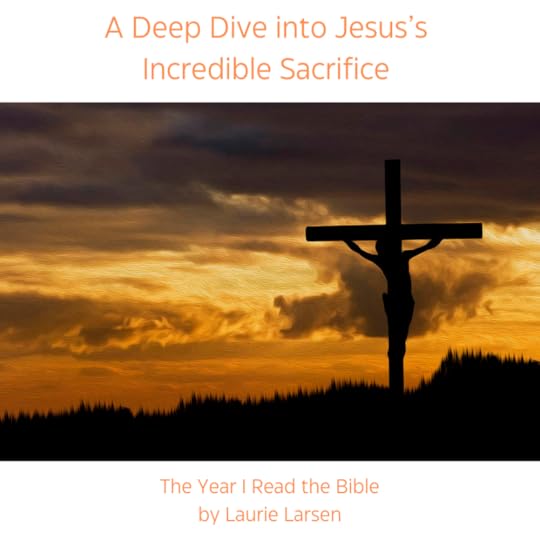
In my journey of sharing what I’ve learned about the Bible, we’ve now reached the crucifixion. That brutal, horrible, most painful of endings. As a child I always wondered, after the joyous celebration of Palm Sunday … why? Why did he have to die this way?
But of course, he had to die this way, there was no other way; and also, it’s not an ending! He also had to rise again to accomplish God’s magnificent, amazing story of redemption.
Let’s read Matthew’s account of the death of Jesus, chapter 27, translated here in the New International Version:
45 From noon until three in the afternoon darkness came over all the land. 46 About three in the afternoon Jesus cried out in a loud voice, “Eli, Eli, lema sabachthani?” (which means “My God, my God, why have you forsaken me?”).
47 When some of those standing there heard this, they said, “He’s calling Elijah.”
48 Immediately one of them ran and got a sponge. He filled it with wine vinegar, put it on a staff, and offered it to Jesus to drink. 49 The rest said, “Now leave him alone. Let’s see if Elijah comes to save him.”
50 And when Jesus had cried out again in a loud voice, he gave up his spirit.
51 At that moment the curtain of the temple was torn in two from top to bottom. The earth shook, the rocks split 52 and the tombs broke open. The bodies of many holy people who had died were raised to life. 53 They came out of the tombs after Jesus’ resurrection and went into the holy city and appeared to many people.
54 When the centurion and those with him who were guarding Jesus saw the earthquake and all that had happened, they were terrified, and exclaimed, “Surely he was the Son of God!”
There’s a great deal to unpack in that short section. Let’s dig in: (I’m using analysis provided by a website called Enduring Word):
45 From noon until three in the afternoon darkness came over all the land.
Bible scholars say that although this unusual darkness lasted for three hours, this was not the entire time Jesus was on the cross. Jesus hung on the cross for about six hours, between 9:00 in the morning and 3:00 in the afternoon. The first three hours of Jesus’ ordeal were in normal daylight, so that all could see that it was in fact Jesus on the cross, and not a replacement or an impostor.
A natural eclipse wouldn't have lasted anywhere near three hours. This darkness was also remarkable because it happened during a full moon – during which time Passover was always held – and during a full moon it is impossible that there be a natural eclipse of the sun.
Interestingly, there was historic documentation outside of the Bible for this phenomenon. Phlegon, a Roman historian wrote: “In the fourth year of the 202nd Olympiad, there was an extraordinary eclipse of the sun: at the sixth hour, the day turned into dark night, so that the stars in heaven were seen; and there was an earthquake.”
Nineteenth century Bible analyst Charles Spurgeon interpreted the darkness this way: “The darkness is the symbol of the wrath of God which fell on those who slew his only begotten Son. God was angry, and his frown removed the light of day.”
46 About three in the afternoon Jesus cried out in a loud voice, “Eli, Eli, lema sabachthani?” (which means “My God, my God, why have you forsaken me?”).
Okay guys, I’m going to attempt to explain this one, but let’s all be assured that as author Larry White said in his article, Why Did Jesus Cry “My God, my God, why have you forsaken me?” it’s puzzling, to say the least: “In the most critical moment of the entire Bible, the moment when Jesus dies on the cross, he shouts a phrase that can be puzzling to those of us reading the account so many centuries later: ‘My God, my God, why have you forsaken me?’"
I’ve always considered that it was Jesus’s human side that caused him to express this thought after so many hours of pain, humiliation and disrespect. In fact, the night before, after the Last Supper with his disciples, he went to the Mount of Olives to pray and he was agonizing about the crucifixion then: (Luke 22:42) “Father, if you are willing, take this cup from me; yet not my will, but yours be done.”
It's completely understandable that he was scared and he wanted out of it. Although any of us, when faced with the horrible circumstance of dying by being nailed to a cross and hanging there for six hours, would be completely justified in feeling forsaken by God … Jesus didn’t.
After all, he’s not half human and half God. He’s fully human and fully God. Remember he was part of creating this plan from the very beginning – before Adam and Eve created sin in the first place. See my early blog here as a reminder.
Enduring Word interprets it this way. Read it, then read it again, because I guarantee it takes a little while to settle in!
“The agony of this cry is significant. It rarely grieves man to be separated from God or to consider that he is a worthy object of God’s wrath, yet this was the true agony of Jesus on the cross. At some point before He died, an awesome spiritual transaction took place. God the Father laid upon God the Son all the guilt and wrath our sin deserved, and He bore it in Himself perfectly, totally satisfying the wrath of God for us.
As horrible as the physical suffering of Jesus was, this spiritual suffering – the act of being judged for sin in our place – was what Jesus really dreaded about the cross. This was the cup – the cup of God’s righteous wrath – that He trembled at drinking. On the cross, Jesus became, as it were, an enemy of God who was judged and forced to drink the cup of the Father’s fury. He did it so we would not have to drink that cup.”

In the absolute worst moment of his life on earth, Jesus the Teacher teaches us one more thing: his anguished words are taken directly from Psalm 22, written by King David and thought by Bible scholars to be a vision where David saw this exact moment of the future death of God’s Messiah. By quoting the first line of the familiar psalm, Jesus’s Jewish followers would recognize it and go look up the rest of it and understand.
It is the greatest proof and illustration of God’s immense love for all mankind to expect His Son to take on the payment for all of our human sins, so that the debt is paid forever and always by Jesus.
51 At that moment the curtain of the temple was torn in two from top to bottom.
What is this curtain the Bible references? Within the holy temple in Jerusalem, a veil (or curtain) separated the Holy of Holies—the earthly dwelling place of God’s presence—from the rest of the temple where men dwelt. This signified that man was separated from God by sin. Only the high priest was permitted to pass beyond this veil, and only once each year to enter God’s presence for all of Israel and make atonement for their sins. Historians estimate that the curtain was nearly sixty feet tall.
The size and thickness of the veil make the events occurring at the moment of Jesus’ death on the cross so much more momentous. The fact that it was torn from top to bottom symbolizes that it was God above who did the tearing. Above all, the tearing of the veil at the moment of Jesus’ death dramatically symbolized that the shedding of His own blood was a sufficient atonement for sins. It signified that now the way into the Holy of Holies was open for all people, for all time, both Jew and Gentile.
The earth shook, the rocks split 52 and the tombs broke open. The bodies of many holy people who had died were raised to life.
Wowza! A supernaturally extended eclipse of the sun, an earthquake, a 60-foot long curtain in the temple a mile away tore from top to bottom, and now bodies of holy people who were dead and buried were raised to life! It’s clear what God is proclaiming about this event: this was no ordinary crucifixion and only God Almighty can perform these miraculous events! And don’t you guys forget it!
54 When the centurion and those with him who were guarding Jesus saw the earthquake and all that had happened, they were terrified, and exclaimed, “Surely he was the Son of God!”
The scene at the crucifixion of Jesus was so striking that even a hardened Roman centurion confessed that this was the Son of God! This man had supervised the death of perhaps hundreds of other men by crucifixion, but he knew there was something absolutely unique about Jesus. This event was undeniable and impossible to pass off as just another Roman crucifixion! Just as Jesus performed miracles to convince people that He was the Son of God, God used miraculous events to convince everyone that He is Lord!
We’ve taken a deep dive into the crucifixion and as I said before, it requires repetition and study to fully understand everything God was doing as the Master Planner. But at the heart of it all is His immense and unending love for us, his children.
Let’s pray: Dear Jesus, we thank you, and thank you again, and never stop thanking you for what you did on that cross for us. By taking human sin onto your back, you paid the ultimate price of redemption to the Father. You, who were sinless, took on the weight of human sin, past, present and future. You died for me. You died for everyone who has ever lived. And forgiveness is ours because of you. We love you and we ask that you help us show it every day of our lives. Amen.
February 13, 2025
Abiding in Jesus, the True Vine

During the earthly ministry of Jesus, he provided his followers with many analogies to help them comprehend who he was – what he was. Sometimes an illustration enlightens people more than straight information. It’s why he used parables as a favorite way to share godly truths.
Throughout the gospels, Jesus uses many illustrations to try to drive his point home:
· I am the Bread of life (John 6:35)
· I am the Light of the World (John 8:12)
· I am the Door (John 10:7)
· I am the Good Shepherd (John 10:11)
· I am the Resurrection and the Life (John 11:25)
· I am the Way, the Truth and the Life (John 14:6)
· I am the True Vine (John 15:1)
Today we’ll look deeper into this last one, and I will share insights gained from a Bible Study I took last summer led by the talented and knowledgeable Van Weston of Pawleys Island, South Carolina. First let’s read:
“I am the true vine, and my Father is the vinedresser. 2 Every branch in me that does not bear fruit he takes away, and every branch that does bear fruit he prunes, that it may bear more fruit. 3 Already you are clean because of the word that I have spoken to you. 4 Abide in me, and I in you. As the branch cannot bear fruit by itself, unless it abides in the vine, neither can you, unless you abide in me. 5 I am the vine; you are the branches. Whoever abides in me and I in him, he it is that bears much fruit, for apart from me you can do nothing.” (John 15: 1-5, English Standard Version)
Like the other analogies Jesus used, vines and vineyards were items very familiar to people in that region and timeframe. Wine and grape juice were common drinks, so almost everyone would be knowledgeable about how grapes were grown. Just like an eagle is a symbol of national identity to Americans, a vineyard was then a symbol to designate Israel. The nation of Israel had long been known as a vineyard connected to God who makes them fruitful.
By calling himself the true vine, Jesus was using a parable full of meaningful imagery. The Old Testament contains numerous references to God being a vine dresser, vital in the people of Israel becoming fruitful. Let’s take a look at a few:
(Isaiah 5:1-2) I will sing for the one I love a song about his vineyard: my loved one had a vineyard on a fertile hillside. He dug it up and cleared it of stones and planted it with the choicest vines. He built a watchtower in it and cut out a winepress as well. Then he looked for a crop of good grapes, but it yielded only bad fruit.
(Jeremiah 2:21) I had planted you like a choice vine of sound and reliable stock. How then did you turn against me into a corrupt, wild vine?
Hmmm. It’s looking like when God used the vineyard/vine image to the people of Israel before Jesus’s coming, it was usually to illustrate how they had disappointed him; how they hadn’t lived up to his expectations and failed him. Now, Jesus uses the True Vine image, and his Father is the vinedresser.
At the time Jesus shares this analogy, what else is going on? Here’s a short timeline: He has already washed his disciples’ feet. The Last Supper is completed. Judas has already left the gathering to contact the officials about Jesus’ whereabouts, and Jesus has already predicted Peter’s denial.
This is one of the last lessons Jesus shares with his most devoted before his arrest. He knows how short his time is now – this lesson had to have been a huge priority in his mind. He shares that the vine is the source of fruit-bearing ability in the plant. The plant is completely dependent on the vine to live. The branch without the vine is dead. And no branch can bear fruit by itself; it must remain in the vine.
Jesus is urging us to abide in him – it’s the only way we can remain alive and continue to bear fruit. This message of abiding in him was very important to Jesus – it must’ve been. He used the term ABIDE seven times in nine verses. By pure repetition alone, not to mention the timing of his lesson, we know this message was urgently important to Jesus that his followers understand.
Abide is the verb used in this passage by Bible translations such as the King James Version, the American Standard Version and the English Standard Version. Other translations use the word Remain (the New International Version, for example). And others use the words Stay Joined (Contemporary English Bible) and others say Live in Me (the Living Bible).
They’re all synonyms to express Jesus’s intention. Which one speaks to you the most? Which imagery drives home Jesus’s point that he wants us to abide in him, remain in him, stay joined with him and live in him? They all mean that he wants us to know that he is our home. We are ever present with him and that’s how branches and fruit remain strong.
Artist Angel Ambrose of the Angel Ambrose Fine Art Studio in Bloomington, Illinois has created this evocative painting, inspired by her love of John 15.
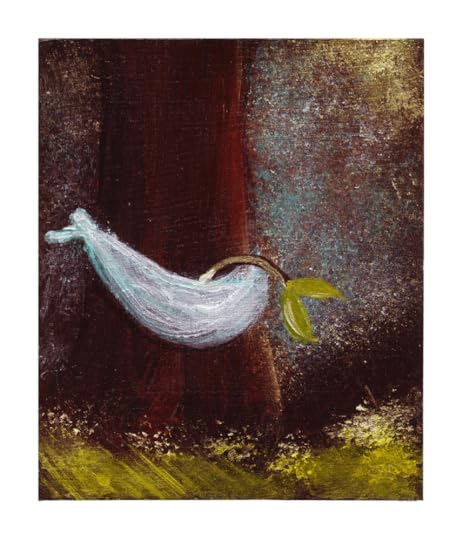
Angel and I had a very inspiring conversation recently and here are some of her thoughts that poured into her creation of this amazing piece of art:
“Probably my favorite book in the Bible, John gives a perfect word picture of what it means to abide in Christ. This word picture from John 15 speaks of being grafted into The True Vine (Jesus) by The Good Gardener (Father), and remaining there to produce fruit, more fruit, and much fruit (by the Holy Spirit’s direction).
When a plant is grafted into a host, it must lose its roots (as we are to lose our life) and then it is grafted into a stronger “host” plant. The stronger plant must be cut, in order to make a place for the graft. Jesus The Perfect Vine had to be cut to make a place for us. Once the cut was made in the Vine and the graft, the two become one. This is a beautiful picture of union, oneness, marriage, Jesus and the Bride, etc. One!
The Gardener binds up the wound. When a plant is grafted, the host and graft are bound together to meld. The white cloth signifies the eternal covenant (Genesis 17:7). He binds up our wounds and we become one (John 17:23). The white cloth is the covenantal token of the transaction that takes place.
This is the Great Exchange! Jesus took our sin. We became just. He took our filthy garments and gave us robes of righteousness. He died a criminal’s death, we became prophets, priests, and kings. He gave His all, so we could have it all.
We are His Heirs and He is our great reward.”
My hearty thanks go to both Van Weston and Angel Ambrose for all the input into this inspiring topic!
Let’s pray: Dear Jesus, thank you for the invitation – the directive – to abide in you. Thank you for coming up with so many ways to teach us who you are. Thank you for never giving up on getting through to us. Thank you for persevering till the final moments of your time on earth to continue to teach us. And thank you for holding tight to that promise, thousands of years later. Help us to abide in you and to teach others as well. Amen.
February 3, 2025
Peter’s Denial – What Was He Thinking?

Although the Twelve Disciples don’t fully understand or accept it, Jesus knows things are getting real. At what has come to be called The Last Supper, we’ve already seen that Jesus predicts Judas’ betrayal of him.
But he also makes another prediction: Peter’s Denial.
Mark 14:27 – 31 reads, “You will all fall away,” Jesus told them, … But after I have risen, I will go ahead of you into Galilee.”
Peter declared, “Even if all fall away, I will not.”
“Truly I tell you,” Jesus answered, “today – yes tonight – before the rooster crows twice you yourself will disown me three times.” But Peter insisted emphatically, “Even if I have to die with you, I will never disown you.” And all the others said the same.
Oh, Peter is so sure, so emphatic. He’s spent three years of his life following Jesus, being exposed to amazing and dangerous and miraculous things! He’s been named by Jesus to be the Rock which His church will be built upon, and he learned a painful lesson about standing in the way of God’s plan for Jesus. Now, he’s proclaiming loyalty all the way till death, if needed.
But unfortunately, Jesus is right (of course he is) and Peter does deny Jesus three times before the rooster crows twice. In Mark 15:67, one of the servant girls of the high priest recognized him. Verse 68: But he denied it. “I don’t know or understand what you’re talking about,” he said, and went out into the entryway.
That same servant girl pointed him out to those standing around and this time he denied it in front of the onlookers. In verse 70: After a little while, those standing near said to Peter, “Surely you are one of them, for you are a Galilean.”
Peter began to call down curses, and he swore to them, “I don’t know this man you’re talking about.” Immediately the rooster crowed the second time.
When Peter recalled Jesus’ prediction, he broke down and wept.
It’s not necessarily unbelievable that Peter denied having anything to do with Jesus when faced with the possibility of arrest and crucifixion himself. I mean, he is human, and therefore, wrought with weaknesses. But it sure is difficult to believe that at this stage of his ministry, having spent day in and day out with Jesus for three years, learning firsthand everything he was teaching, that Peter would do this, isn’t it?
The website, GotQuestions, addresses the reason behind Peter’s denial this way:
“A reason for Peter’s failure was fear. To his credit, although all the others had fled (Mark 14:50), Peter still followed Jesus after His arrest, but he kept his distance so as not to be identified with Him (Mark 14:54). There’s no question that fear gripped him. From the courtyard, he watched Jesus being falsely accused, beaten, and insulted. Peter was afraid Jesus would die, and he was fearful for his own life as well. The world hated Jesus, and Peter found that he was not prepared to face the ridicule and persecution that Jesus was suffering. Earlier, Jesus had warned His disciples as well as us today, “If the world hates you, keep in mind that it hated me first” (Matthew 24:9). Peter quickly found he wasn’t nearly as bold and courageous as he had proclaimed, and in fear he denied the One who had loved him.”
I suppose it’s easy for us modern Bible readers to cast judgement on Peter in his weakness, but honestly, what would we have done in the same situation? Mark 14:50 tells us the remaining ten disciples, besides Judas, had fled the scene when Jesus was arrested, seeking safety from a distance! Peter was the Number One disciple, the leader of the team, and he at least accompanied Jesus after his arrest, even if he could simply keep an eye on him from a distance. His fear kept him from being loyal to his Teacher and in his panic, he declared that he didn’t know Jesus in order to not suffer the same fate.
But have no fear … the story circles around from something terrible to something wonderful. God’s perfect plan emphasizes that despite our own human weaknesses, failures, and sins, Jesus Christ is eager to forgive us and restore our relationship with him.

John 21: 15-19 brings Peter’s three-time denial around full circle. At this point, Jesus’ empty tomb has been discovered and he was presenting himself to Mary Magdalene and the disciples. Simon Peter was out fishing, with little luck with friends, and Jesus, standing on the shore, shouts out to them to put the nets on the other side of the boat. They did, and the catch was so huge they were unable to haul in the net.
Ring any bells? Yes! Because Jesus did this same exact miracle with Peter in Luke chapter 5 when he first recruited Peter (then named Simon) to be a disciple! The fact that Jesus did the same miracle with Peter after his death and resurrection, and especially with Peter feeling horrible that he’d betrayed his Lord, is a glimpse of the forgiveness that Jesus will offer, and the amazing role that Peter will move forward to play in Jesus’s expanding Church.
Can you imagine how ecstatic Peter is? Jesus is back, he’s performed a miracle for Peter, and maybe his mistake of betrayal isn’t the end of his close relationship with Jesus after all. Then Jesus uses a technique to drive the message home.
Just as Peter denied Jesus three times, Jesus asks Peter the same question three times. Let’s read it in John:
When they had finished eating, Jesus said to Simon Peter, “Simon son of John, do you truly love me more than these?”
“Yes, Lord,” he said, “you know that I love you.”
Jesus said, “Feed my lambs.” Again Jesus said, “Simon son of John, do you truly love me?”
He answered, “Yes, Lord, you know that I love you.”
Jesus said, “Take care of my sheep.” The third time he said to him, “Simon son of John, do you love me?”
Peter was hurt because Jesus asked him the third time, “Do you love me?” He said, “Lord, you know all things; you know that I love you.”
Jesus said, “Feed my sheep. I tell you the truth, when you were younger you dressed yourself and went where you wanted; but when you are old you will stretch out your hands, and someone else will dress you and lead you where you do not want to go.” Jesus said this to indicate the kind of death by which Peter would glorify God. Then he said to him, “Follow me!”
Peter's failure leads to forgiveness and a beautiful restoration! In Jack Zavada’s article, Peter Denies Knowing Jesus, we read: “This gentle exchange between Jesus and Peter showed that the apostle was forgiven and restored to his place of leadership. Three times Peter had denied the Lord. Now, three times he affirms his love for Jesus. Likewise, three times the Lord commissions Peter to care for the flock.
The Lord's command to Peter to take care of his sheep meant that Peter had been fully forgiven and restored. No matter what mistakes we make in the past, no matter how far we fall, Jesus wants to restore us to a place of trust.
After Peter's denial, the Lord lovingly forgave and restored him to a place of trust.
Do you feel like you've failed the Lord so miserably that there's no hope for you? Let Peter's story encourage you. No matter how far you’ve fallen, or how deep your shame, Jesus will forgive and restore you and give you a purpose in his service.”
This story fills my heart with hope and joy. I hope it does yours too. I encourage you to think about mistakes you’ve made in your life that might be holding you back in your relationship with Jesus. You know he will forgive you and remove whatever barriers have formed between the two of you. Let’s pray now:
Dear Lord, thank you for giving us this story of you and Peter. Despite the mistakes he made, you forgave him and welcomed him back into your kingdom and the circle of your love. Please forgive us for all those times we’ve denied you or disappointed you or didn’t represent you in our own lives. Please help us to remember to feed and take care of your sheep. Amen.
January 22, 2025
The Approach of a King
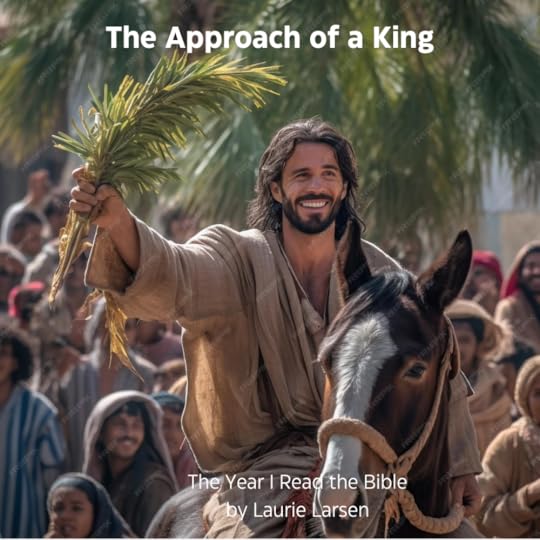
Jesus was reaching the completion of his three-year-long earthly ministry. Scholars estimate that in the three years he was teaching through the region of Galilee and Judea, he covered 3,125 miles … by foot. In fact, by sandal-clad foot!
Can you even imagine that? If you were determined to set out and walk over a thousand miles a year for three years, would you select leather sandals to do the job? (I realize Jesus didn’t have the option of going to the local Fleet Feet store and purchasing a new pair of Hokas, but still …)
Jesus knew that his time was coming. He had already predicted his death to his disciples three times, in straightforward language – not parables which they would have to interpret.
He had performed a great number of miracles in these final days – feeding the five thousand with five loaves and two fish – walking on water to reach his disciples in a boat – lots of healings. He knew exactly what was coming, and when it had to happen.
A full week before the Passover feast in Jerusalem, Mark 11:1 – 3 tells us, As they approached Jerusalem and came to Bethphage and Bethany at the Mount of Olives, Jesus sent two of his disciples, saying to them, “Go to the village ahead of you, and just as you enter it, you will find a colt tied there, which no one has ever ridden. Untie it and bring it here. If anyone asks you, ‘Why are you doing this?’ say, ‘The Lord needs it and will send it back here shortly.’”
I love the specificity of this plan. Jesus knows that an unbroken colt will be exactly where he tells them to look. And as Mark 11:4 tells us, They went and found a colt outside in the street, tied at a doorway. As they untied it, some people standing there asked, “What are you doing, untying that colt?” They answered as Jesus had told them to, and the people let them go.
Just like Jesus said. He’s the Lord not only of the big and majestic, but also of the details.
I couldn’t help but wonder … was there some reason why Jesus chose an unbroken, or untrained colt on which to ride into Jerusalem? I figured there must be. So, I did some research.
The website, Enduring Word says, “Jesus established that He would enter Jerusalem riding on a colt. He deliberately chose a young donkey, not a stallion, not a horse, and not coming on foot. This is because in that day, to come riding a colt – as opposed to a mighty war-horse – was to come as a man of peace. Jesus didn’t come to Jerusalem as a conquering general, but as a suffering (though triumphant) servant.”

The Old Testament is filled with the stories of the prophets God sent to the people of Israel to teach them and prepare them for what would eventually come in the form of his son, Jesus. This exact plan that Jesus was putting into action with the young colt, is a manifestation of what the prophet Zechariah said in his book, chapter 9 verses 9 and 10: Rejoice greatly, Daughter Zion! Shout, Daughter Jerusalem! See, your king comes to you, righteous and victorious, lowly and riding on a donkey, on a colt, the foal of a donkey. I will take away the chariots from Ephraim and the warhorses from Jerusalem, and the battle bow will be broken. He will proclaim peace to the nations. His rule will extend from sea to sea and from the River to the ends of the earth.
What a joyous and welcome message! And what a joyous parade into the city it was for Jesus! A cloak was draped on the colt’s back, Jesus climbed on and made his way into Jerusalem. The people along the road threw their own cloaks on the ground for the colt to step on, and as Mark 11:8 says, “others spread branches they had cut in the fields.”
What branches? Over the centuries this was interpreted as palm branches, because in the Christian church this celebration has come to be known as Palm Sunday. The people are singing, “Hosanna! Blessed is he who comes in the name of the Lord! Blessed is the coming kingdom of our father David! Hosanna in the highest heaven!” (Mark 11: 9 – 10)
Such a happy and festive time. I wish I’d been there, don’t you? I love this slice from the life of Jesus because it simply feels right. For much of Jesus’ ministry, He was despised and rejected by those he came to teach. Often the adoring crowds followed Him only for what they could get from Him, and most of His audience rejected any kind of personal commitment to Jesus. All of that was different on this day.
On this day, they lavished attention and honor on Jesus. They used their clothes as a saddle for Jesus and as a red carpet for the colt He rode on. Considering the expense and value of clothing in that day, this was generous praise.
But … it didn’t last. The violent and brutal end is coming quickly, and we all know it, don’t we?
Why, if it was so clear in the book of the Jewish prophet Zechariah that described exactly as Jesus would be approaching, and when so many people welcomed him with praise, was there even a doubt of Jesus’s purpose?
Because … there were other prophecies that contradicted Zechariah’s. Let’s take a look at this prophecy in the Book of Daniel, chapter 7: In my vision at night I looked, and there before me was one like a son of man, coming with the clouds of heaven. He approached the Ancient of Days and was led into his presence. He was given authority, glory and sovereign power; all nations and people of every language worshiped him. His dominion is an everlasting dominion that will not pass away, and his king is one that will never be destroyed.
So many Jews of the time (and indeed, to the current day), felt that the Messiah would be coming as a mighty fighting conqueror, a triumphant general of a strong army.
Enduring Word shows us what the victory parade of a triumphant general looked like back then: “We call this event the “Triumphal Entry,” but it was a strange kind of triumph. If you spoke of Jesus’ Triumphal Entry to a Roman, they would have laughed at you. For them, a Triumphal Entry was an honor granted to a Roman general who won a complete and decisive victory and had killed at least 5,000 enemy soldiers. When the general returned to Rome, they had an elaborate parade.
First came the treasures captured from the enemy, then the prisoners. His armies marched unit by unit, and finally the general rode in a golden chariot pulled by magnificent horses. Priests burned incense in his honor and the crowds shouted his name and praised him. The procession ended at the arena, where some of the prisoners were thrown to wild animals for the entertainment of the crowd. That was a Triumphal Entry, not a Galilean Peasant sitting on a few coats set out on a pony.”
But that was never God’s plan.
Jesus’s own words in the Sermon of the Mount, those that have come to be known as The Beatitudes say … “Blessed are the humble, for they will inherit the earth.” (Matthew 5:5)
Jesus never says, “Blessed are the strong for they will fight their enemies and win.” He says, “Love your enemies and pray for those who persecute you.” (Matthew 5:44)
It was a revolutionary change in thinking back then when he said it, and guess what: it still is. This is one of the hardest to understand practices in Jesus’ teaching and certainly to put into practice. It goes against our human nature and our cultural practices.
But Jesus demonstrated it himself when he chose to ride in on the humble untrained colt.
Let’s pray: Dear God: please help us be like Jesus. Let us approach the events in our life with humility and help us always to come to you when we need a reminder. Keep our eyes always focused on you, dear Lord. Amen.
The Curious Case of Judas Iscariot
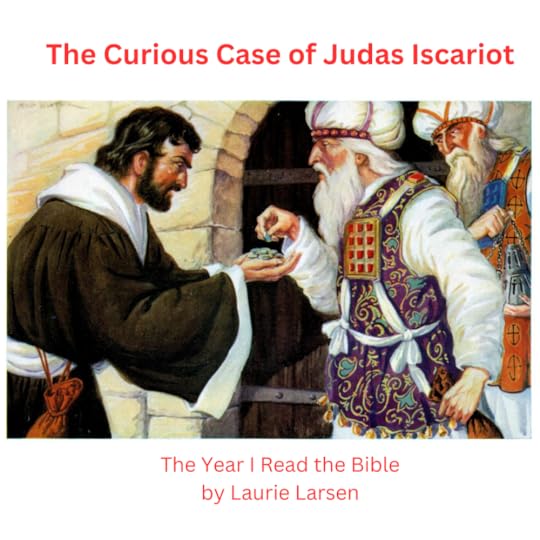
When you hear the name of Judas, what is your first reaction?
· He betrayed Jesus
· He sold Jesus to the Romans for thirty pieces of silver
· He’s a bad guy through and through.
Sometimes we’ll refer to a particularly nasty betrayer in our modern life as “a Judas.”
Have you heard the phrase, “Your name is mud.”? Well, that phrase is actually, “Your name is Mudd,” as in Dr. Samuel Mudd who gave medical help to John Wilkes Booth, who broke his leg while escaping after shooting President Abraham Lincoln in 1865. Although Dr. Mudd was accused and investigated as being a conspirator of Booth’s in the assassination, it was a widely circumstantial case, and he was never found guilty.
Regardless, 160 years later the derogatory phrase based on the good doctor’s name is still in our American lexicon. And calling someone a Judas for purposely betraying some has now lasted over two thousand years.
I’m sure if you’re reading this essay, you know the story of Judas, but let’s do a short recap. He was one of Jesus’s Twelve Disciples – in his inner circle. He traveled all over with Jesus and the rest of the chosen, and he was given the job as being the group’s treasurer, ie, he was in charge of their money. When Jesus sent them out in pairs to the surrounding lands to preach and perform miracles, Judas was one of them.
But during the Last Supper, let’s read: (Mark 14:17-21): When evening came, Jesus arrived with the Twelve. While they were reclining at the table eating, he said, “Truly I tell you, one of you will betray me – one who is eating with me. They were saddened, and one by one they said to him, “Surely you don’t mean me?” “It is one of the Twelve,” he replied, “one who dips bread into the bowl with me. The Son of Man will go just as it is written about him. But woe to that man who betrays the Son of Man! It would be better for him if he had not been born.”
The fact that Jesus shared this admonishment with the attendees of his Last Supper means that he knew that one of his inner circle of Twelve Disciples would betray him. He knew this because it was God’s plan.
Because man stepped outside the will of God, His chosen people in the Old Testament made annual sacrifices of animals and fruits to atone for sin. These sacrifices ended with the “once and for all” sacrifice made by Jesus Christ when he freely allowed himself to be arrested, tried, convicted and put to death.

It's a big, magnificent, horrible, wonderful plan for a loving Father to make to secure salvation for all his earthly children. But one of the details of this big plan is to get the Roman soldiers in the right place at the right time to arrest Jesus.
Judas played that role.
He was preordained by God to play that treacherous role of betraying the Lord and Savior of the world, an act that would lead to Jesus’s death.
That brings up a couple questions for me:
Did Jesus know Judas would be the one? Jesus definitely knew one of the Twelve would betray him, based on what he told them at the Supper. But he did not tell them which one. In fact, the others were astounded and asked, “Surely you don’t mean me?”
But if we piece together clues in the gospels, we conclude that Jesus did indeed know that it would be Judas. Mark 14:20 (listed above) specifies that the one who betrays him will not only have broken bread with Jesus, but be “the one who dips bread into the bowl with me.” I’m sure you’ve seen the famous artistic recreation of The Last Supper by Leonardo DiVinci. Thirteen people attended the dinner, all sitting around a table. It wouldn’t have been likely that all of them would’ve dipped their bread in the bowl set near Jesus. Evidently Judas did.
Matthew goes a step further in his gospel. Let’s look at chapter 26 verse 25: Then Judas, the one who would betray him, said, “Surely you don’t mean me, Rabbi?” And Jesus answered, “You have said so.”
The gospel writer John also confirmed that Jesus knew not only that one of his disciples would betray him, but he knew it would be Judas. And going further, he’d known since his ministry had begun. John 6:64: For Jesus had known from the beginning which of them did not believe and who would betray him.
Did Judas know he would be the one? Judas was a faithful follower of Jesus for most of Jesus’s ministry. But ultimately, he betrayed Jesus which led to Jesus’s arrest, and subsequently, death. Why did Judas do it?
The immediate reason is he received money for the transaction (thirty pieces of silver). There are suggestions in the gospels that Judas was highly motivated by money. John 12:5-6 documents Judas’s words as, “Why wasn’t this perfume sold and the money given to the poor? It was worth a year’s wages.” He did not say this because he cared about the poor but because he was a thief; as keeper of the money bag, he used to help himself to what was put into it.
Judas's potential motives for betraying Jesus have been widely debated, with some suggesting he may have been disillusioned with Jesus's peaceful message and was seeking a more forceful Messiah.
But I think the definitive answer to this question is, yes, Judas knew he would be the one. Why? Because he initiated the contact with the chief priests. Matthew 26: 14 says, Then one of the Twelve – the one called Judas Iscariot – went to the chief priests and asked, “What are you willing to give me if I deliver him over to you?” So they counted out for him thirty pieces of silver. From then on Judas watched for an opportunity to hand him over.
Since Judas’s betrayal of Jesus was in God’s plan, did he have any choice in the matter? To answer this important question, I’m going to quote an expert! This is from Dr. Roger Barrier’s article, Did Judas Have a Choice, or Was He Predestined to Betray Jesus?
“Did Judas have any choice in the matter? It seems not. He could not avoid or change his destiny. He was foreordained to commit this brutal act. The moment Satan entered Judas the die was cast (Luke 22:3).
Now we come to the free will part. Once Judas had completed his ungodly mission, he was free to make things right with Jesus. Jesus died for Judas, too. You know that if Judas had fallen on his knees, repented and asked for forgiveness that Jesus would have welcomed him into the kingdom.
Peter also betrayed his relationship with Christ; but he is in Heaven's glory. Why? Because he returned to Christ and repented. The Bible says Peter not only felt shame and despair, he repented and asked for forgiveness.
The story of Judas is a paradox. He is the epitome of predestination along with its opposite, free will. He had to betray Jesus, but he was free to return to Christ if he had so wanted. Wouldn't that have made a great story of redemption and salvation!”
And with that, let’s pray: Dear Father, thank you for the amazing complexity of your Living Word, and your plan to redeem mankind through your son Jesus. Please continue to give us all the thirst for knowledge; for digging into the books of the Bible and learning more each time we read it. Illuminate the divine truths that you want us to see and help us to apply them into our own lives. Amen.
Jesus Knew All Along
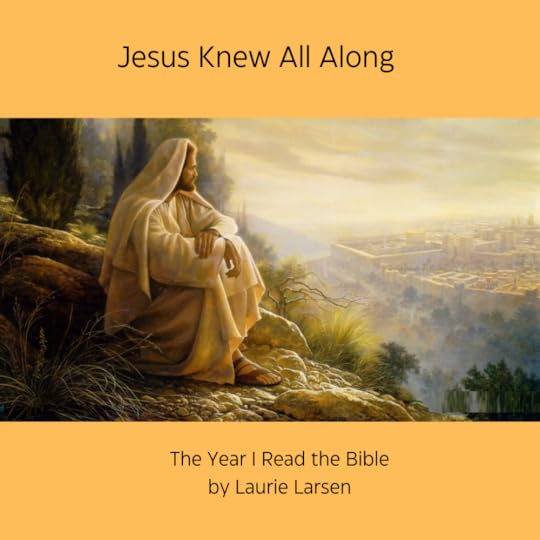
Because Jesus was born, like every other child, into a human family, and grew up influenced by his parents, his schoolmates, and other people in his life, it’s easy to forget for a moment that he wasn’t like any other child. Yes, he was fully human, but he was also fully divine, the Son of God, the moment of his birth. As he grew up and completed his young adult years, he was in close communication with his heavenly father. There are so many scripture references in which he told people who he was.
Remember when, as a young boy, Jesus was lost for days during the annual trip to Jerusalem for Passover, and finally they found him in the temple. His parents were frantic looking for him, and he just said, “Why wouldn’t you think I was in my Father’s house?” (Luke 2:41)
Remember when Jesus returned to his hometown, Nazareth, and he read the scroll of the prophet Isaiah in his local synagogue. Verse 29 of Luke chapter 4 says, Then he rolled up the scroll, gave it back to the attendant and sat down. The eyes of everyone in the synagogue were fastened on him. He said, “Today this scripture is fulfilled in your hearing.”
This gives me the shudders. He knew why he was there on earth, and he and God were in sync about how his work would be accomplished. Remember all those times Jesus left the clamor and hub bub of his daily ministry to walk away and pray? He was reconnecting with God to make sure he knew the plan.
But despite Jesus’ certainty of the end goal of his ministry – crucifixion and resurrection – his disciples and followers had a difficult time understanding it. Jesus often spoke in parables and left the symbolic stories up to their interpretation. Or even when he told them directly, “I’m going to be crucified and I will rise again on the third day,” they didn’t want to accept it. They were in the throes of daily activity, and they couldn’t lift their heads up to see the big picture.
Matthew 16:21-23 reads, From that time on Jesus began to explain to his disciples that he must go to Jerusalem and suffer many things at the hands of the elders, the chief priests and the teachers of the law, and that he must be killed and on the third day be raised to life. Peter took him aside and began to rebuke him. “Never, Lord!” he said. “This shall never happen to you!” Jesus turned and said to Peter, “Get behind me, Satan! You are a stumbling block to me; you do not have in mind the concerns of God, but merely human concerns.”
Wow.
Take a moment and put yourself in Peter’s shoes. I’m sure he was devastated by this harsh rebuke. Peter and Jesus had a history, and they were very close. Simon Peter was one of the first men Jesus selected to follow him, and Simon dropped everything in his life to do what Jesus asked him. Jesus had just said this to Simon in verse 17 of that same chapter: “Blessed are you, Simon son of Jonah … for I tell you that you are Peter, and on this rock I will build my church … I will give you the keys of the kingdom of heaven…”
So, Peter could be thought of as “the Number One Disciple,” the ONE of all of them Jesus chose to be the rock to build his church upon. Why then, did he command, “Get behind me, Satan” to Peter, one of his most devout followers? It seems harsh and out of character for Jesus.
It could be that the plan Jesus had revealed to them was starkly different than what they thought they had been doing with him all along. Contrary to their expectations of Him, Jesus explained that He had not come to establish an earthly Messianic kingdom at that time. The disciples were not prepared for this new revelation of the Messiah’s purpose. Though Peter understood His words, he simply could not reconcile his (and certainly all Jews’) long-held view of the conquering Messiah with the suffering and death Jesus spoke of. So, Peter “began to rebuke Him” (verse 22) for having such a fatalistic mindset.
It could also be that Peter had grown to love Jesus so much and had always considered himself a protector of the Messiah, that if this crazy plan were to come true, it would mean that he (Peter) had failed to protect Jesus. And he personally couldn’t bear to witness the death and destruction of Jesus after how close they’d become.
Think of someone you love very deeply – maybe a son, daughter, or even a parent. If that person tells you something horrific that is going to happen to them, your first impulse would be to deny it. “No, sweetheart, you’re not going to fail out of school! You’re going to be fine!” (even though their GPA had slipped below the acceptable mark.)
“Mom, no, you don’t need to have that surgery that will require weeks or months of recovery. You’re going to be fine!” (even though the test results showed surgery was the last possible option.)

It’s denial, right? By insisting that this person you love more than anything doesn’t need to go through a painful experience, maybe you can make it so. Maybe that’s why Peter said what he did. Either ignorance of the plan or denying the pain and suffering his Lord would have to go through, he wasn’t onboard.
Jesus’s extreme response to Peter’s denial made it absolutely clear that Peter was wrong and that he’d better get onboard quickly. Jesus didn’t put a soft loving arm on his shoulder and thank him for his concern and say, “Thank you for trying to save me from this, but it’s not going to work, buddy.” No, he shouted at Peter and called him the worst name that ever existed – Satan! And not only was Peter just not onboard, he was acting as a stumbling block to Jesus following the will of his father. If Peter didn’t understand and accept what Jesus was doing, Jesus would be better off without him!
Did Peter want to stay in oblivious denial? Or did he want to join Jesus and support him in the unimaginable plan Jesus had been walking toward all along? Peter was not setting his mind on the things of God—His ways, His plans, and His purposes. Instead, his mind was set on the things of man, the things of the world and its earthly values. Jesus was saying that the way of the cross was God’s will, the plan of redemption for all mankind.
Of course, we’ll be seeing more of Peter and the choices he makes after Jesus has been arrested. But that will be for another day. I think what we can learn from Peter holding strong to not believing Jesus’ declaration of the will of God is this: at the time, Jesus’ stern reprimand did not make sense to Peter. However, Jesus’ indictment presents a profound message for us.
We can easily see that Peter had the wrong perspective of God’s plan for Christ’s suffering and death. But we must also see how easily we can become an unwitting spokesperson for Satan. This is especially true when we lose sight of God’s plan for us. This comes about when our focus is on our careers, our possessions, our security, and the things of the world rather than upon sacrifice and service and the proclaiming of God’s message. When Peter’s focus shifted to his own desires and plans, Jesus rebuked him to get back on track. May our focus always be on God and His plans that we may never experience a similar rebuke from our Lord.
(My thanks to the website GotQuestions “Why Did Jesus Say to Peter, Get Behind Me Satan? for insights on this topic.
Let’s pray: God, sometimes we have to face unwelcome news in our lives as Christians. Sometimes we think that our way of handling a situation is preferable to your way. Help us to always keep our focus on you and draw you into our lives so we understand what you would have us do. Help us never to be that unwitting spokesperson for Satan, our enemy. Amen.
January 20, 2025
Praying for Miracles – What if They Work? (What If they Don’t?)

The Bible is filled, in both the Old and New Testaments, with stories of miracles performed by God, Jesus, the disciples, and prophets. Powerful stories that result in unlikely battles won, escapes accomplished, impossible pregnancies, and the multiplication of food and drink. These documented biblical miracles bring up the hope that they could still occur, under the right set of circumstances, in the world today.
Have you ever experienced a miracle yourself? You quite possibly have, and either know it, or maybe you weren’t aware that it was, indeed, a miracle from God. I recently listened to an audiobook filled with stories of real-life miracles. It was a very uplifting and heartwarming read, and most of the miracles involved God helping someone out of a life-threatening situation, healing a deadly medical condition or helping a woman conceive a baby when doctors felt it was impossible.
Mark 11:23 shows us Jesus saying, “Truly I tell you, if anyone says to this mountain, ‘Go, throw yourself into the sea,’ and does not doubt in their heart but believes that what they say will happen, it will be done for them.”
Wow, think about that. In all my days I’ve never heard of a mountain actually throwing itself into the sea, and especially not at the order of a human. So was Jesus using an analogy? Was he exaggerating to make his point about the powerful outcome of prayer?
He goes on to say (in verse 24): “Whatever you ask for in prayer, believe that you have received it, and it will be yours.”
Okay! That seems pretty straightforward. All we have to do is ask for it, and believe it, and it will happen.
But …
What if it doesn’t happen? You probably agree with me that we’ve all prayed for things that simply haven’t happened. Does that mean we didn’t believe hard enough? That we weren’t worthy to ask for something and have the Lord Almighty grant it? That our faith simply wasn’t strong enough?
I’ve heard people say, “Prayer’s not like having a genie in a bottle and all you have to do is rub the side and it happens.” I agree with that thought.
Is there a clue in the rest of the conversation Jesus was having with his disciples in this section? Verse 25 says, “And when you are praying, if you hold anything against anyone, forgive them, so that your Father in heaven may forgive you your sins.”
Hmmm, so does that mean in order for your prayers to be fulfilled, you have to forgive anyone you have a grudge against first? That could take some doing …
Sometimes I feel like I’m giving a list of tasks to God to accomplish to fulfill my will. Maybe it’s the healing of someone who’s sick, or securing a job that I really want that would make a big difference in the life of my family. Or any number of requests of God to achieve my heart’s desires. After all, isn’t that what verse 24 tells us? “Whatever you ask for in prayer, believe that you have received it, and it will be yours.”
But what about God’s will? I believe God has a plan for every situation, and it would not be difficult to believe that his will is different than mine. He sees the whole picture, while I only see what’s right in front of me. He may plan to fulfill a prayer request, but not right now. Maybe not until another sequence of events happens first. It could be years from now. And undoubtedly, his timing would be better than mine anyway!
In her article, What Happens When You’re Praying for a Miracle and You Don’t Get It, author Shari Yates shares these strategies for things to do when you’re waiting for the miracle you prayed for, and it doesn’t seem to be happening:
1. Do not exhaust yourself trying to make sense of it. We are not supposed to understand everything because we simply can’t understand everything. But we are supposed to pray about everything so we can have the peace that is better than understanding. We get a chance to believe even when we don’t get our way. Faith isn’t seeing — it’s continuing to believe even when we do not see.
2. Do not stop asking God for His help. After we don’t see the miracle we asked for, many of us back off from praying because we feel inept or maybe we wonder if God even cares. The Bible does tell us to place our hands on sick people and pray for them (Mark 16:15-18). It doesn’t say, “You make them well if your faith is strong enough.” It teaches us to reach out in faith. But only God’s power works the miracles. Our responsibility is to pray, but the weight of the outcome was never meant to be on our shoulders.
I saw this comment in my research, that I liked, “Prayer is not like instant cocoa. Just add water and there you go. Sometimes yes, prayer can see a result instantly, but usually that is not the case. Prayer is often answered in ways we don't expect, at times we don't expect.”
And it’s most important not to get discouraged or lose faith when you don’t see the result you’re praying for. The very act of prayer is an important one: we get the chance to put ourselves in a posture of prayer, to push away all the competing distractions of our life, to focus on Almighty God and speak openly about what’s on our mind. In addition to speaking, we can also listen to see if a message is delivered to our heart and mind. Time spent in prayer is time building and enhancing our personal relationship with God.
And I can’t really think of any other activity I have on my calendar today that is nearly as important as that.
Let’s pray: Dear God, help us to remember to come to you with all our requests and thanks and praise. We know you want to hear from us, and we know that prayer builds and strengthens our relationship with you. When we ask for those things that don’t see an immediate response, please help us stay patient and strong and wait for your divine timing to do your work. Amen.



